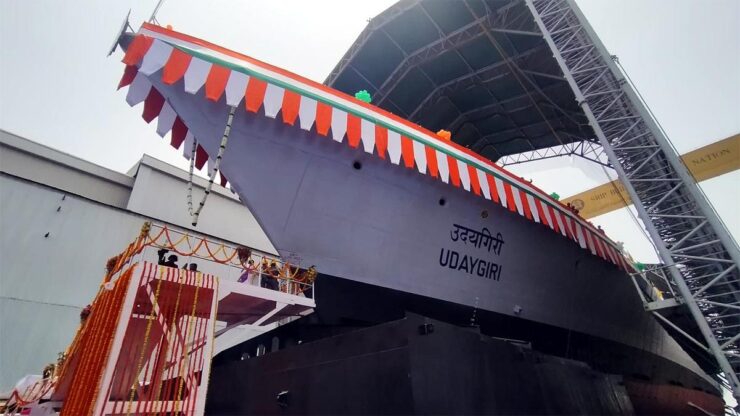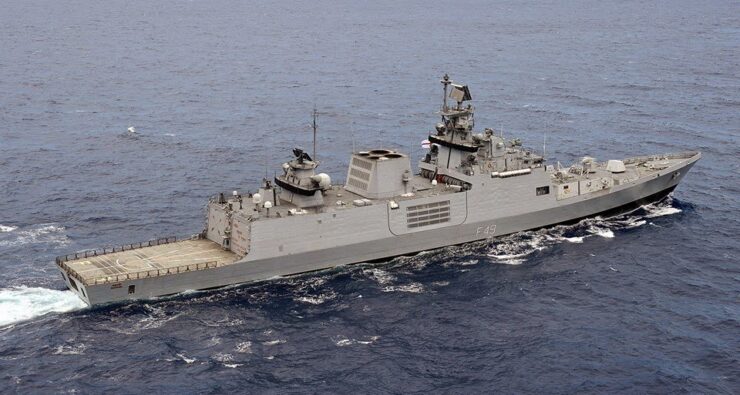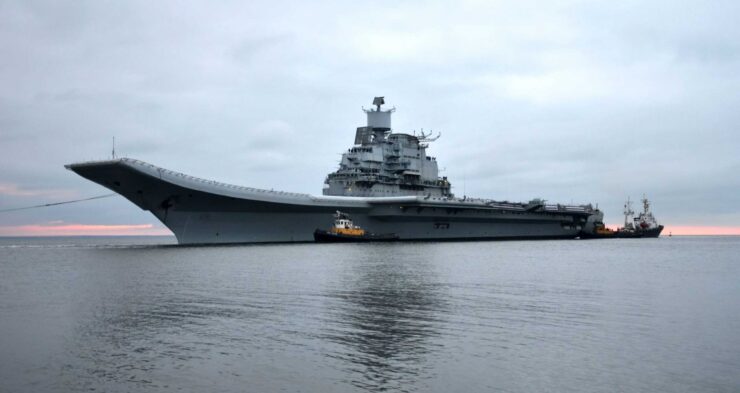
The addition of two more frontline warships to the Indian Navy on May 17 is another milestone in the Atmanirbhar Mission. The Surat (Project 15B), the Destroyer, and the Udaygiri (Project 17A) Frigate can be showcased as examples of India’s self-reliance in the defence sector.
At Mumbai’s Mazagon Docks, Defence Minister Rajnath Singh said that the warships project shows India’s strategic strength and self-reliance prowess to the world. This is the first time two indigenously built warships have been launched simultaneously.
The Surat is the fourth ship of the Project 15B Destroyers, an upgraded one of the P15A (Kolkata Class). The work on the construction of the four ships began in January 2011. The cost touched Rs 35,000 cr, up from the projected cost of Rs 29,643-odd crore. The P15B is the next generation of stealth-guided missile destroyers. The four ships are named after four major cities in India. The first ship was commissioned in 2021, and the second and third ships have been launched and are at different stages of outfitting trials, according to the Navy. The ships would be commissioned from 2022 to 2024, once a year.
Medium-Range Surface-to-Air Missiles (Bharat Electronics Limited, Bengaluru), BRAHMOS Surface-to-Surface Missiles (BrahMos Aerospace), Indigenous Torpedo Tube Launchers (Larsen & Toubro), Anti-Submarine Indigenous Rocket Launchers (Larsen & Toubro), and 76mm Super Rapid Gun Mount (BHEL) are among the indigenous weapons aboard the Surat.
In the case of Udayagiri, it is the third ship of Project 17A Frigates. It is an improvisation of P17 (Shivalik Class). It is the reincarnation of the erstwhile Udayagiri, the Leander Class ASW Frigate, which tackled many challenging operations from 1976 to 2007. Seven ships are under construction under the P17A programme. According to the Navy, various novel concepts and technologies like Integrated Construction, Mega Block Outsourcing, Project Data Management, etc. have been adopted for the first time in the indigenous project. The first two ships were launched in 2019 and 2020.
The credit for designing the 15B and P17A ships goes to the Directorate of Naval Design (DND). Around 75% of the orders for equipment and systems have been sourced from MSMEs. The float of these two warships has boosted the strength of the Navy, which is always on guard because of China’s quest to monopolise the blue economy through the Indian Ocean Region (IOR). The Destroyer can play multiple roles, including anti-submarine, anti-ship, and anti-aircraft, while the Frigate is suited for a defensive role. The Destroyer, the guided missile, can duck enemy radar. It gives target data directly to the warship’s weapon system.

Naval strength must be up
It has become imperative for India to boost the strength of the navy. The country’s coastal line runs to 7516 kms with 1197 offshore islands besides a vast rich exclusive economic zone. The country’s two major naval bases in the West Coast – Mumbai and Kochi have reached their full capacities with no scope for further expansion. There is a need to have one more Naval base on the Western side is crucial.
India has a fleet of 16 submarine, Ballistic Missile Submarine (SSBN), Nuclear Power Attack Submarine (SSN) – each one, Diesel-Electric Submarine (SSK) 14 and Air-Independent Propulsion nil. Of these INS Arihant , SSBN submarine was inducted in 2016. This is a good strength the Navy. In the same series is INS Arighat which is SLBM.
India’s next ambitious project P-75 India submarine project under the strategic partnership model has taken a temporary beating with France’s Naval Group company expressing its inability to participate in the project under which six conventional submarines are to be constructed in India for the Indian Navy. The announcement came days before Prime Minister Narendra Modi embarked on his visit to France in May first week this year. The Request for Proposal (RFP) put across by India is not acceptable to the Naval Group, a major submarine building company of France. The total projected cost is Rs 43,000 cr. After years of planning and with the strategic partnership model hitting almost the dead-end, now India has to re-evaluate and rework on the model’s stumbling blocks to carry on with this project.
Any delay in implementation of the plans is a costly thing at this point. China is keeping India on its toes in the IOR. Since China is way ahead of India when it comes to gaining access to strategic ports and accessing military bases, India has no choice but to be vigilant as well as assertive. India is strategically aligning with its neighbours and America to counter China. But no country can be sure of drawing strength from other countries’ military strength during a conflict. This has become obvious in the Ukraine war. India has to modernise its navy by including attack submarines, missile-carrying warships, and aircraft carriers.
It is a well-known fact that China has adopted strategies that are against the established and acceptable means to pocket smaller countries to establish its sea power. China maintains no transparency in its deals to open ports or issue loans to countries like Sri Lanka or Pakistan. Many smaller countries in the IOR are pushed into debt, thanks to China.
Even India is making smart moves by drawing agreements with many countries in the IOR to get military access to their bases. Being on good terms with America and France is also giving additional strength to India. Being in the Quadrilateral Security Dialogue has been one way of drawing strength from many advanced countries. In 2018, India grabbed the proposal made by French President Emmanuel Macron to have a strategic alliance of India-France-Australia, mainly to maintain maritime security to counter China’s menacing growth in the IOR. India has been participating in multilateral naval exercises regularly. The most recent exercise was with Thailand, the UK, and Japan, among other countries.
In the global list of the top 10 strongest nations, India occupies the 7th position in 2022. India at present is reported to have 295 naval assets, including an aircraft carrier and a dozen submarines.

The global warship and naval vessel markets are seeing a steady expansion. In 2021, the value reached $60.7 billion, according to IMARC, a market research company at the global level. The growth is expected to touch $85.1 billion by 2027. However, after the Ukraine war, there could be certain changes in the policies of many countries towards security. As long as there are conflicts among the nations, be it geopolitical or maritime, the budget for defence keeps increasing. While the global pandemic stalled economic growth, the Ukraine war is pushing vulnerable countries to increase their military spending.
As per the market projection, it is the North America and Asia-Pacific regions that are going to see significant growth in naval capabilities. This also means adapting to newer technologies and purchasing newer-generation naval vessels, meaning ships equipped with weapons.
Aircraft carriers witnessed a good market share in 2021. A carrier is nothing but an airbase on the sea. The US’s latest vessel, which is to be deployed in 2022, can carry no fewer than 75 aircraft, and the next plan is to have carriers that can carry nearly 90. It is said that China’s new aircraft carrier can hold 40 aircraft.
Vikrant, the carrier
Then comes the question: how come India is satisfied with just one aircraft carrier? The INS Vikramaditya, the Russia-origin platform used by the Indian Navy, can hold 34 aircraft. The two aircraft carriers that have been decommissioned are INS Vikrant and INS Viraat. The indigenously built carrier, IAC Vikrant, will symbolise self-reliance when commissioned as it is designed by the Directorate of Naval Design. It is scheduled to be commissioned on August 15, 2022, according to Prime Minister Narendra Modi. Interestingly, this aircraft carrier, which can accommodate 36–40 aircraft, including a MiG-29K, has a long history.
The work on the ship’s design began way back in 1999, when George Fernandes was the defence minister. It was launched in 2013 and the basin trials were completed by the end of 2020. The ship trials began in 2021. Also, the flight trials are expected to be completed by mid-2023. The total cost of the project is projected at Rs 23,000 cr in 2021 and will be constructed at the Cochin Shipyard Limited.
There has been an inordinate delay in completing the project for various reasons. It was scheduled to be commissioned by 2021. The Indian government had said that one of the reasons for the delay was the non-supply of aviation equipment from Russia.
Anyways, both Vikrant and Vikramaditya figure in the list of top 10 aircraft carriers in the world, according to Marine Insight, a maritime industry guide. America has 11 aircraft carriers, while China and the UK have two each.
– The writer is an Aerospace and Defence Analyst & Director ADD Engineering Components (India) Pvt Ltd (An Indo- German Company).








